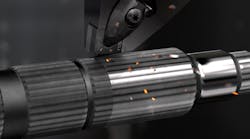Manufacturing evolves to meet the demands of customers and novel products. Sometimes, this means machine shops need to change their approach to normal steps or processes, including how they set-up to process parts they may have been producing with regularity. The advent of very hard specialty alloys and composites has been especially consequential for shops machining aerospace parts, dies and molds, or energy-system components.
Machining hard materials requires special attention to technique and tool design, in order to achieve the expected results and performance standards. No matter how desirable it may be in terms of the finished product and its performance, some harder materials demand specific approaches, and the results may be less than optimal if the right steps are not taken during set-up. Equally, the shop runs the risk of reducing the performance life of cutting tools. Here’s a quick guide on how to process hard materials, and achieving highly accurate and desirable results.
Tool designs — Successful machining for hard materials begins with wise tool selection. They must be rigid and offer high precision, and the tool must be matched to the different steps in the process and the geometry of the workpiece, like so:
• Ball end mills. These are a good choice for roughing as well as finishing hard materials. With their large working radius, ball end mills help disperse heat as well as force, which reduces the likelihood of workpiece deformation. They help the operator get close to the desired net shape at a high operational speed.
• Bullnose (corner radius) tools. Hard-material workpieces with flat and broad “floors” benefit from bullnose tools. The tradeoff is that their smaller radius does not dissipate heat as well as you might wish, and it is more prone to causing chipping.
• Square end mill. Parts with sharply angled corners where the wall meets the floor usually will get the best result with a square end mill. This is typically the only time you may use one however, as it tends to focus rather than dissipate heat and force.
Tool and insert materials — It pays to be mindful of the tool and insert materials you choose as well. Carbide resists deflection when machining hard items, but make sure it's solid carbide. Plated carbide tools can sometimes chip easily. Ceramic tools are another popular choice for hard machining.
Cubic boron nitride (CBN) inserts are an alternative that has gained popularity as product designs have called for harder materials. For example, sintered metals are extra-hard and feature microstructures that cause “microchatter” and early insert failure. Carbide inserts may fail under pressure, but CBN inserts (containing titanium and tungsten carbides) will not.
Roughing —To machine a hard material it’s usually wise to use the soft machining technique during the roughing phase. This means beginning work using materials that have not yet been heat-treated. In this “annealed” state, the item is softer and easier to work with, allowing you to lessen the stress on the die or mold, or other hard-material product.
You can make the most of the roughing stage and reduce the required finishing work by selecting fast toolpath patterns that remove a lot of material quickly. Adaptive clearing is ideal for this and is a good choice for working with superalloys, hardened steel, and other hard items such as iron.
Remember to count your flutes, too. End mills with at least four flutes are good for roughing hard materials, although four to eight will further improve your results.
Temperature and vibration control — Without proper temperature and vibration control, you risk undermining the accuracy of your tools, as excessive heat tends to change the morphology of the workpiece surface.
The first step in temperature control is to use a cutting fluid to provide lubrication, as well as remove loose chips as you work. Mineral oils and emulsifiable oils are the best choices — just be sure there’s no interruption in the supply while you work. A lack of coolant will cut short the service life of your tools.
Another step to minimize heat buildup and retention is to pay close attention to the radial step-over of your tool of choice. This refers to the distance between individual parallel cuts in a series. For hard materials, your radial step-over distance should be between one-fifth and one-tenth of the tool diameter.
As mentioned, tool rigidity is another important factor. According to MC Machinery Systems’ Danny Haight, “you need a solid machine tool … with bridge construction and a rigid spindle.”
When it comes to working with iron, hardened steels, superalloys and other hard materials, Haight recommended looking for high-quality machines with hand-scraped surfaces, too, as “they are more accurate and better at dampening vibration.”
Finishing — Even if you performed roughing on your hard material while it was in its annealed state, the finishing process takes place after heat treatment. As with temperature control, fine-tuning the finishing steps requires attention to your step-overs.
Use the raster pass technique to finish your hard material workpieces. Hardened materials are very strong, but they can be brittle without the right finishing technique. During raster passes, the cutting tool intersects with the parallel vertical lines you created in the roughing stage. This allows for high precision and high-quality surface finishes without the material succumbing to its brittleness.
With the right approach to machining hard materials, it’s possible not only to produce highly accurate and attractive results, but also to maximize the service life of your tools.
Megan Nichols is a STEM writer and blogger who writes on a wide range of scientific topics at schooledbyscience.com. Her recent work has included 9 Popular Choices for EMI Shielding and Save Money by Fixing and Preventing Compressor Leaks. Follow Megan on Twitter @nicholsrmegan.






